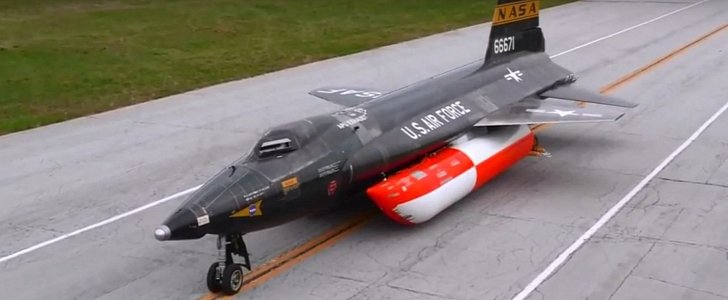Many people think of the Lockheed SR-71 Blackbird as the fastest airplane in the world. Up to a point, they are right. However, the real record holder is a relatively unknown model called the North American X-15.
Remember the X-1 with which Chuck Yeager reached Mach 1? Well, this is just like that but six times better. The X-15 is the fastest manned aircraft, having reached a speed of Mach 6.7 or about 7,200 kilometers per hour, a feat it attained on October 3, 1967.
Several flights were carried out by the three prototypes between June of 1959 and December of 1968 when the program ended. Thirteen flights made by eight pilots were so high that they later received "wings" from NASA, recognizing them as astronauts. Of the total 199 missions, two even qualified as true space missions with an altitude of over 100 kilometers (62.1 miles).
So why aren't there any airplanes that fly into space if they could do this stuff way back in the 60s? Well, the X-15 required a piggyback from a B-52 mother ship up to a certain altitude to conserve fuel. Early flights used two Reaction Motors XLR11 liquid-propellant rocket engines and could reach "only Mach 4." Later flights were undertaken with a single XLR99 rocket engine generating 57,000 pounds-force (250 kN) of thrust.
The XLR99 rocket was a real gas guzzler, using up to 15,000 pounds (6,804 kg) of propellant for 80 seconds. These were the first rocket engines that could be throttled equipped for manned missions.
This aircraft features stuff that's cutting edge even by today's standards. For example, the ejection seat could be used at speeds of up to Mach 4 and 120,000 feet (37 km) altitude. Fortunately, they never had to use it. However, it may have been the most advanced such safety feature ever made, featuring fins that would guide it until it reached a safe enough altitude. Can you imagine catapulting half way to space?
Another interesting feature is a so-called wedge tail to give it hyper-sonic stability. A vertical-tail area equal to 60 percent of the wing area was required to give the X-15 adequate directional stability. The wedge produced as much drag as an entire F-104 Starfighter.
To our eyes, the X-15 is not a true aircraft. However, it answered many questions people had. Can a man pilot an aircraft into space? Can he re-enter the atmosphere? Can he land it safely? Yes, yes and yes.
Several flights were carried out by the three prototypes between June of 1959 and December of 1968 when the program ended. Thirteen flights made by eight pilots were so high that they later received "wings" from NASA, recognizing them as astronauts. Of the total 199 missions, two even qualified as true space missions with an altitude of over 100 kilometers (62.1 miles).
So why aren't there any airplanes that fly into space if they could do this stuff way back in the 60s? Well, the X-15 required a piggyback from a B-52 mother ship up to a certain altitude to conserve fuel. Early flights used two Reaction Motors XLR11 liquid-propellant rocket engines and could reach "only Mach 4." Later flights were undertaken with a single XLR99 rocket engine generating 57,000 pounds-force (250 kN) of thrust.
The XLR99 rocket was a real gas guzzler, using up to 15,000 pounds (6,804 kg) of propellant for 80 seconds. These were the first rocket engines that could be throttled equipped for manned missions.
This aircraft features stuff that's cutting edge even by today's standards. For example, the ejection seat could be used at speeds of up to Mach 4 and 120,000 feet (37 km) altitude. Fortunately, they never had to use it. However, it may have been the most advanced such safety feature ever made, featuring fins that would guide it until it reached a safe enough altitude. Can you imagine catapulting half way to space?
Another interesting feature is a so-called wedge tail to give it hyper-sonic stability. A vertical-tail area equal to 60 percent of the wing area was required to give the X-15 adequate directional stability. The wedge produced as much drag as an entire F-104 Starfighter.
To our eyes, the X-15 is not a true aircraft. However, it answered many questions people had. Can a man pilot an aircraft into space? Can he re-enter the atmosphere? Can he land it safely? Yes, yes and yes.



